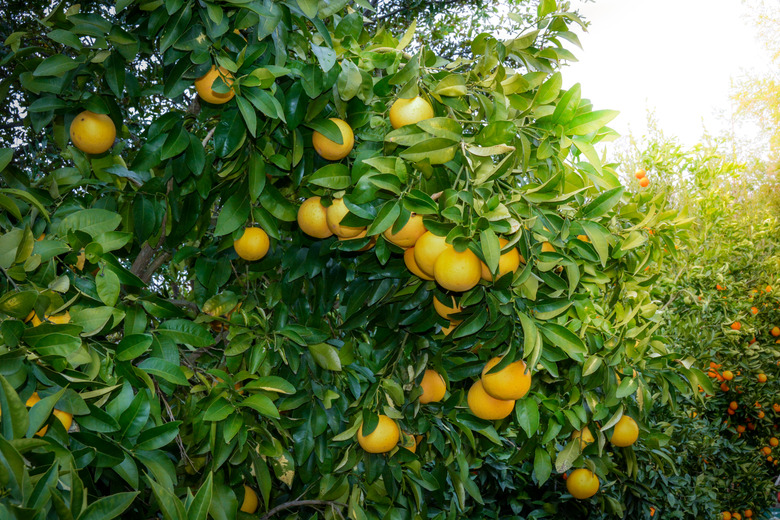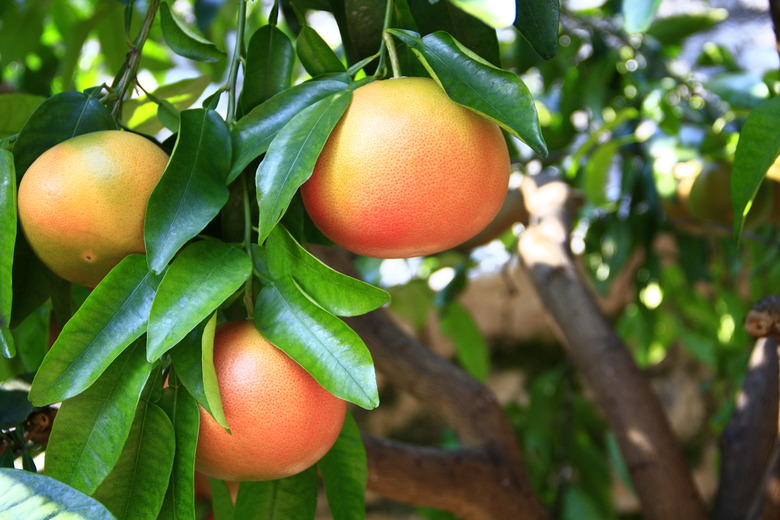How To Grow Grapefruit
We may receive a commission on purchases made from links.
- Best uses for grapefruit
- How to grow grapefruit
- In what zone does grapefruit grow best?
- When should you plant grapefruit?
- Soil, sunlight and water recommendations for grapefruit
- How to winterize grapefruit
- How to harvest grapefruit
- Common pests and other problems for grapefruit
- Common diseases for grapefruit
Reminiscent of the SweeTARTS candies you ate as a kid, grapefruits (Citrus x paradisi) have a delightful tang, and some fruit lovers can't get enough of them. Because the yellow varieties are extremely tart, sweeter red cultivars tend to grace most home gardens and supermarket shelves. Grapefruits are commonly eaten as a breakfast food but can be enjoyed at any time. Like other citrus fruits, they're an excellent source of vitamin C. You do have to protect grapefruit trees from cold weather, but otherwise, they're easy to grow.
Best Uses for Grapefruit
Best Uses for Grapefruit
Although they are evergreen and do possess shiny leaves, grapefruit trees aren't particularly attractive or useful as ornamentals. They're fantastic food producers, however — and a single mature tree can produce fruit in excess of an astonishing 250 pounds of fruit each year when they're 10 years old or older. Young trees take about three years to start producing, but even a young tree's first harvest can exceed 25 pounds. They also produce over the winter when many other fruit trees go dormant.
Reaching 20 to 25 feet in height and about 10 feet wide at maturity, the bushy crown of the grapefruit tree is sometimes used as a privacy screen. You only need one tree to set fruit since grapefruit can self-pollinate, but some gardeners like the look of two trees flanking a patio or home garden entrance. You can also grow dwarf varieties in containers. These trees only grow about 12 feet tall.
How to Grow Grapefruit
How to Grow Grapefruit
- Common Name: Grapefruit
- Botanical Name: Citrus x paradisi
- When to Plant: Spring or fall, but spring plantings are generally best
- USDA Zones: 9-11
- Sun Exposure: Full sun
- Soil Type: Very well-draining soil
- When it's in Trouble: Curling, spotted, yellow leaves; splitting fruit
- When it's Thriving: Bushy habit, shiny green leaves
Starting Grapefruit From a Sapling
It's possible to grow grapefruit trees from grapefruit seeds, but it's generally not recommended. Grapefruit trees don't typically fruit until they are about three years old, but those grown from seed take even longer, waiting five years to bear. And many gardeners are in for a disappointment when a seed-grown tree doesn't bear true to the fruit from which the seed was harvested. Seed-grown grapefruits live shorter lives as well since they are much more susceptible to root rot.
To plant, dig a hole twice as wide as the plant's root ball but about the same depth. Next, remove the young grapefruit tree from its container and examine the growing medium. Some nurseries start grapefruits in an artificial growing medium rather than soil. If this is the case, use your garden hose to gently wash away the growing medium before planting.
Place the plant in the hole so that the plant sits slightly higher than it did in the original container. Backfill the planting hole and firmly tamp the soil. Water the tree immediately after planting. If you're planting multiple trees, space them 15 to 20 feet apart.
Mulching around grapefruit trees isn't recommended. If you feel compelled to mulch around your new tree, make sure you keep the mulch at least a foot away from the trunk.
Like most young plants, grapefruit trees do better if they don't have to compete with grass and weeds. Grapefruit is sensitive to herbicides, however, so it's best to remove weeds by hand. If you need to spray for weeds, carefully wrap the trunk of your grapefruit tree in aluminum foil first to protect it from the chemicals. When applying the herbicide, do so carefully, keeping the chemicals directed at the ground and being careful not to spray the leaves of your grapefruit tree.
In What Zone Does Grapefruit Grow Best?
In What Zone Does Grapefruit Grow Best?
Grapefruit trees like warm days and nights but can survive temperatures in the 20-degree-Fahrenheit range when properly sheltered. Trees planted in USDA plant hardiness zones 9 and warmer will do well but the warmer, the better. If you grow grapefruit in zone 9, know that you'll have to cover your grapefruit tree from time to time when the temperature dips and frost looms. Remember that grapefruits are a bit less cold hardy than oranges.
When Should You Plant Grapefruit?
When Should You Plant Grapefruit?
You can plant young grapefruit trees in the spring or fall, but it's preferable to plant in the spring. This gives the plant more time to establish itself before winter. In warmer areas, grapefruit trees don't really care if you plant them in the spring or the fall. In cooler areas, however, spring plantings give the plants a bit more time to acclimate themselves to their new growing space before colder weather becomes an issue. In zones 9 and 10, mid-February planting is best. In warmer zones, the choice is yours.
Know your soil before you plant. If your soil is heavy or drains poorly, amend it with organic matter before planting. Grapefruit will not tolerate standing in water.
Soil, Sunlight and Water Recommendations for Grapefruit
Soil, Sunlight and Water Recommendations for Grapefruit
Grapefruit trees require full sun and well-draining soil. Under no circumstances will your tree tolerate wet feet. Soggy roots mean lowered fruit production and a significantly shorter life. Amend your soil if it drains poorly and consider planting your trees on small dirt mounds to further improve drainage.
Water young grapefruit trees every three or four days until they get established. Once the roots have taken hold and the plants are growing well, cut your watering schedule to a deep watering about once a week. Always check that the soil around your grapefruit tree is slightly dry before watering. Never assume that a tree needs water without checking.
During your tree's first two or three years, fertilize it with a 6-6-6 fertilizer. Once the tree begins bearing fruit, switch to a citrus fertilizer to make sure it gets all the nutrients it needs for optimal fruit production. Grapefruits like three feedings a year — one in the spring as new growth forms, another as the fruit starts to form and a final application as the fruit matures.
Grapefruit trees are low-maintenance trees that don't really enjoy pruning. Each spring, prune your grapefruit tree with sharp, clean pruning shears only if it sustained frost damage over the winter. Cut away only the dead or damaged wood and leave the rest. Excessive pruning will only serve to stress the tree and will not improve its shape.
How to Winterize Grapefruit
How to Winterize Grapefruit
When your grapefruit tree is young, soil banking is the best way to protect it from winter weather. Around Thanksgiving, treat the trunk of your grapefruit tree with an insecticide and a copper fungicide. Then, build a mound of soil around the trunk of your tree, building it all the way up to the bottom branches. Leave the mound in place until the end of February or the beginning of March. When the winter season is over, carefully remove the mound and wash away the remaining dirt from the tree trunk with a hose.
Mounding will work until your tree is three or four years old. After that, the tree will be too tall for mounding to be practical. Instead, keep an eye on the weather. When there is a danger of frost, cover the tree with a plant cover or tarp. Stake the tarp at the corners to help block cold air and keep the tarp in place.
For further protection, wrap the tree in old-fashioned incandescent Christmas tree lights to generate extra heat. The warmer you keep your tree, the sweeter its fruit will be. For safety, choose lights made for outdoor use. If you're growing dwarf grapefruit varieties in containers, simply bring them inside on cold nights.
How to Harvest Grapefruit
How to Harvest Grapefruit
Although they may still look a bit green, grapefruit is typically ready to harvest in late October. Grapefruit doesn't ripen in the same manner as traditional fruits, so you don't need to worry about harvesting all your grapefruits at one time. In fact, the longer the fruit stays on the tree, the sweeter and larger it gets.
You can begin harvesting your fruit at the end of October and leave others on the tree through the end of production in May. Simply cut your grapefruits off the tree with a pair of clean pruning shears as you need them for a tasty treat.
Your tree likely won't set fruit until its third year. If it does so before, remove the fruit from the tree to encourage the tree to direct its energy toward growing rather than producing fruit. These initial fruits aren't likely to be very tasty, so simply dispose of them after you remove them from the tree.
Common Pests and Other Problems for Grapefruit
Common Pests and Other Problems for Grapefruit
Grapefruits grow relatively pest-free, but home growers do run into problems from time to time. If you're finding holes in your grapefruit, birds or rodents are likely to blame. You can curb the problem by removing any rodent nests from your grapefruit tree and the area nearby. Draping the tree in bird netting will keep birds out.
If the leaves of your grapefruit tree start to curl, cup or become otherwise distorted, look for insects. Aphids or the Asian citrus psyllid are probably present. You can blast aphids off the tree with a shot of water from your hose. If the aphids return or you're dealing with a different insect, like the psyllid, spray your tree with a commercially packaged insecticidal soap.
Caterpillars may also visit and nibble on your grapefruit tree. They generally don't arrive in large numbers, however, so pick off any you find by hand. If you do start to see several, sprinkle some diatomaceous earth around the bottom of the tree.
Common Diseases for Grapefruit
Common Diseases for Grapefruit
Far more problematic than pests are citrus diseases and rots. Unfortunately, the majority of the issues that affect grapefruit trees have no cure. These include root rot, foot rot, psorosis bark scaling and citrus stubborn diseases. If your tree is diseased, the first step is to prune away the affected branches. Make sure you sanitize your pruning shears with alcohol between each cut.
Next, apply a copper fungicide to the tree. If the disease is curable, such as brown rot or citrus canker, this is the product for the job. Once you've applied the fungicide according to label directions, take stock of your care practices. Make sure you're properly watering and fertilizing your tree and adjust your care routine as needed.
Always remember that citrus trees will absolutely not tolerate wet feet. Grapefruit trees left in standing water will almost always develop fatal root and foot rots.
Because grapefruit diseases are often difficult to cure, it's imperative that you prevent them. Make sure you keep grass away from the base of the tree. Generally, it's best to make sure that the area around the tree all the way out to the dripline is clear of competing plants. Make sure you don't damage the trunk of your tree by mowing or weed whacking too closely.
Keep fallen leaves and other debris out of the garden and avoid mulching around grapefruit trees unless there is absolutely no other way to keep down weeds. Protect your tree from freezes and frosts and remove frost-damaged wood each spring.


